technical specifications FIAT 500 2018 Owner handbook (in English)
[x] Cancel search | Manufacturer: FIAT, Model Year: 2018, Model line: 500, Model: FIAT 500 2018Pages: 224, PDF Size: 3.89 MB
Page 190 of 224
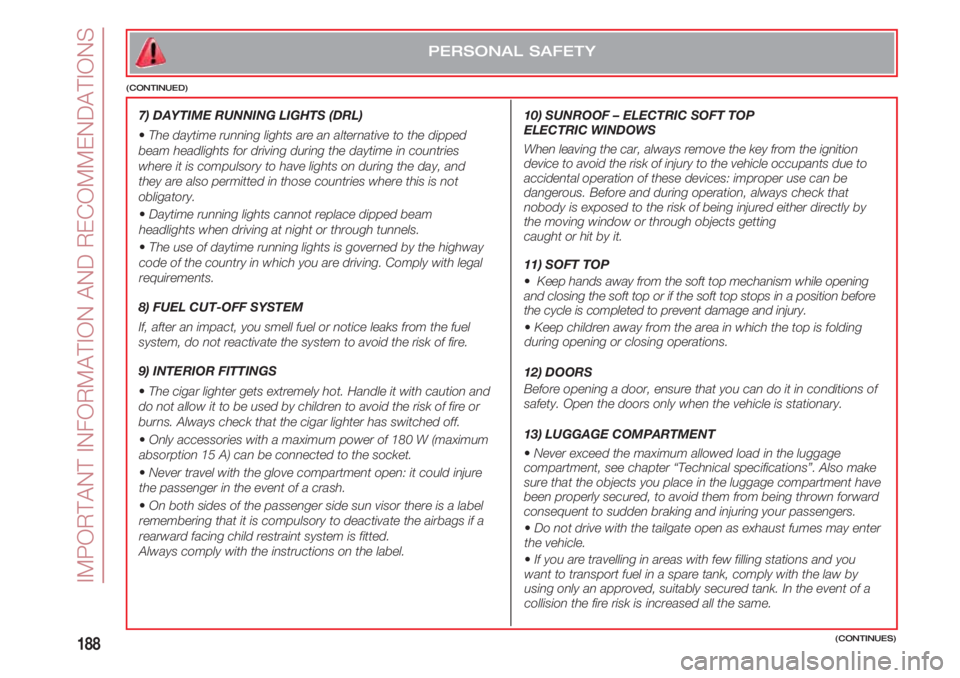
IMPORTANT INFORMATION AND RECOMMENDATIONS
188(CONTINUES)
PERSONAL SAFETY
(CONTINUED)
7) DAYTIME RUNNING LIGHTS (DRL)
•The daytime running lights are an alternative to the dipped
beam headlights for driving during the daytime in countries
where it is compulsory to have lights on during the day, and
they are also permitted in those countries where this is not
obligatory.
•Daytime running lights cannot replace dipped beam
headlights when driving at night or through tunnels.
•The use of daytime running lights is governed by the highway
code of the country in which you are driving. Comply with legal
requirements.
8) FUEL CUT-OFF SYSTEM
If, after an impact, you smell fuel or notice leaks from the fuel
system, do not reactivate the system to avoid the risk of fire.
9) INTERIOR FITTINGS
•The cigar lighter gets extremely hot. Handle it with caution and
do not allow it to be used by children to avoid the risk of fire or
burns. Always check that the cigar lighter has switched off.
•Only accessories with a maximum power of 180 W (maximum
absorption 15 A) can be connected to the socket.
•Never travel with the glove compartment open: it could injure
the passenger in the event of a crash.
•On both sides of the passenger side sun visor there is a label
remembering that it is compulsory to deactivate the airbags if a
rearward facing child restraint system is fitted.
Always comply with the instructions on the label.10) SUNROOF – ELECTRIC SOFT TOP
ELECTRIC WINDOWS
When leaving the car, always remove the key from the ignition
device to avoid the risk of injury to the vehicle occupants due to
accidental operation of these devices: improper use can be
dangerous. Before and during operation, always check that
nobody is exposed to the risk of being injured either directly by
the moving window or through objects getting
caught or hit by it.
11) SOFT TOP
•Keep hands away from the soft top mechanism while opening
and closing the soft top or if the soft top stops in a position before
the cycle is completed to prevent damage and injury.
•Keep children away from the area in which the top is folding
during opening or closing operations.
12) DOORS
Before opening a door, ensure that you can do it in conditions of
safety. Open the doors only when the vehicle is stationary.
13) LUGGAGE COMPARTMENT
•Never exceed the maximum allowed load in the luggage
compartment, see chapter “Technical specifications”. Also make
sure that the objects you place in the luggage compartment have
been properly secured, to avoid them from being thrown forward
consequent to sudden braking and injuring your passengers.
•Do not drive with the tailgate open as exhaust fumes may enter
the vehicle.
•If you are travelling in areas with few filling stations and you
want to transport fuel in a spare tank, comply with the law by
using only an approved, suitably secured tank. In the event of a
collision the fire risk is increased all the same.
Page 191 of 224
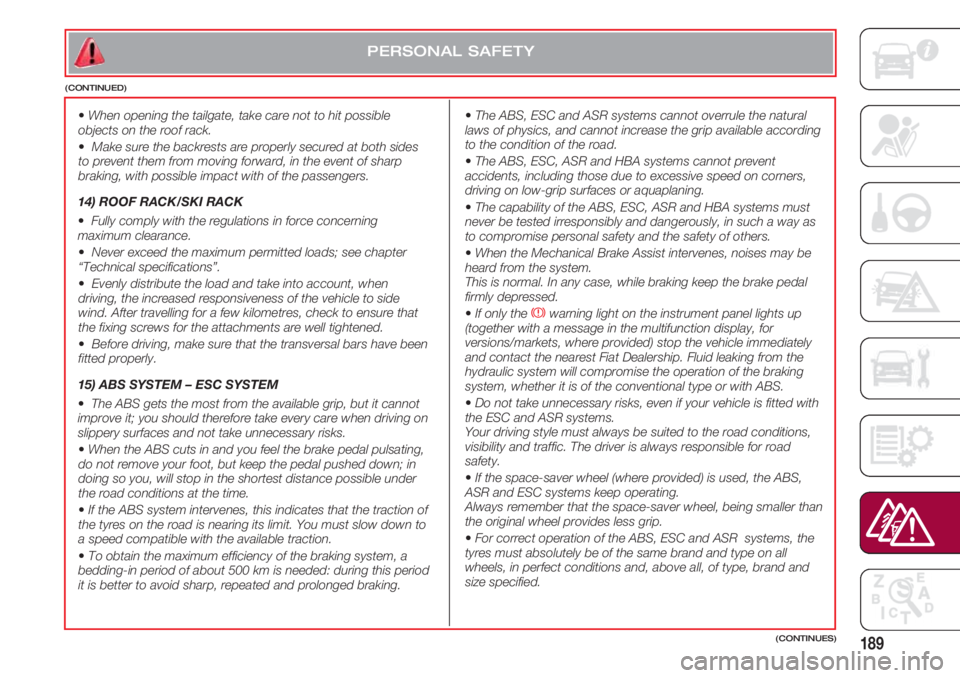
189(CONTINUES)
PERSONAL SAFETY
(CONTINUED)
•When opening the tailgate, take care not to hit possible
objects on the roof rack.
•Make sure the backrests are properly secured at both sides
to prevent them from moving forward, in the event of sharp
braking, with possible impact with of the passengers.
14) ROOF RACK/SKI RACK
•Fully comply with the regulations in force concerning
maximum clearance.
•Never exceed the maximum permitted loads; see chapter
“Technical specifications”.
•Evenly distribute the load and take into account, when
driving, the increased responsiveness of the vehicle to side
wind. After travelling for a few kilometres, check to ensure that
the fixing screws for the attachments are well tightened.
•Before driving, make sure that the transversal bars have been
fitted properly.
15) ABS SYSTEM – ESC SYSTEM
•The ABS gets the most from the available grip, but it cannot
improve it; you should therefore take every care when driving on
slippery surfaces and not take unnecessary risks.
•When the ABS cuts in and you feel the brake pedal pulsating,
do not remove your foot, but keep the pedal pushed down; in
doing so you, will stop in the shortest distance possible under
the road conditions at the time.
•If the ABS system intervenes, this indicates that the traction of
the tyres on the road is nearing its limit. You must slow down to
a speed compatible with the available traction.
• To obtain the maximum efficiency of the braking system, a
bedding-in period of about 500 km is needed: during this period
it is better to avoid sharp, repeated and prolonged braking. • The ABS, ESC and ASR systems cannot overrule the natural
laws of physics, and cannot increase the grip available according
to the condition of the road.
• The ABS, ESC, ASR and HBA systems cannot prevent
accidents, including those due to excessive speed on corners,
driving on low-grip surfaces or aquaplaning.
• The capability of the ABS, ESC, ASR and HBA systems must
never be tested irresponsibly and dangerously, in such a way as
to compromise personal safety and the safety of others.
•When the Mechanical Brake Assist intervenes, noises may be
heard from the system.
This is normal. In any case, while braking keep the brake pedal
firmly depressed.
•If only the
xwarning light on the instrument panel lights up
(together with a message in the multifunction display, for
versions/markets, where provided) stop the vehicle immediately
and contact the nearest Fiat Dealership. Fluid leaking from the
hydraulic system will compromise the operation of the braking
system, whether it is of the conventional type or with ABS.
•Do not take unnecessary risks, even if your vehicle is fitted with
the ESC and ASR systems.
Your driving style must always be suited to the road conditions,
visibility and traffic. The driver is always responsible for road
safety.
•If the space-saver wheel (where provided) is used, the ABS,
ASR and ESC systems keep operating.
Always remember that the space-saver wheel, being smaller than
the original wheel provides less grip.
•For correct operation of the ABS, ESC and ASR systems, the
tyres must absolutely be of the same brand and type on all
wheels, in perfect conditions and, above all, of type, brand and
size specified.
Page 199 of 224
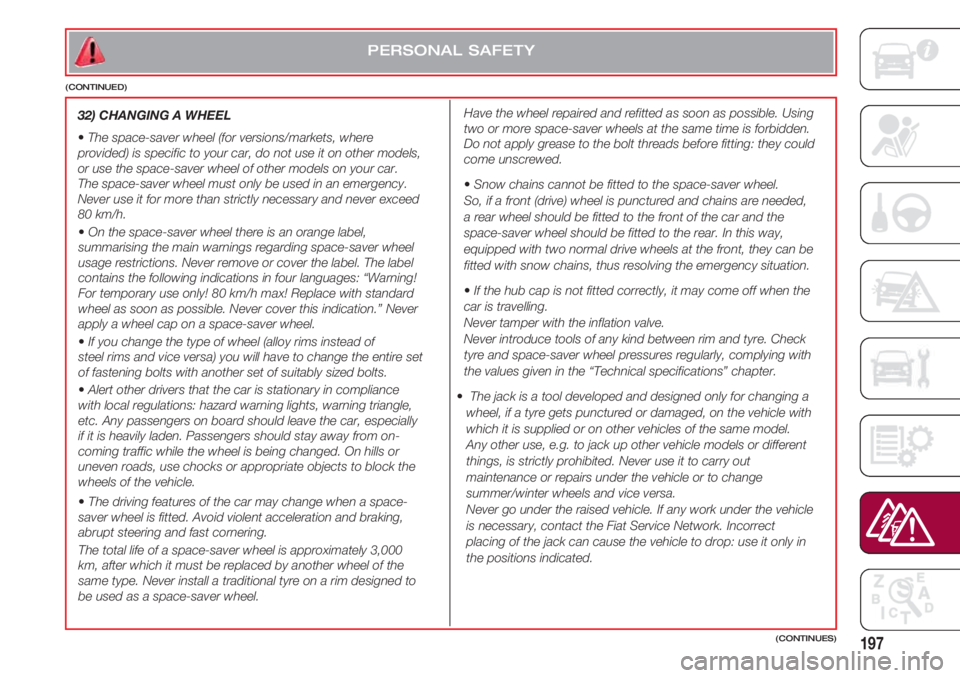
197(CONTINUES)
32) CHANGING A WHEEL
•The space-saver wheel (for versions/markets, where
provided) is specific to your car, do not use it on other models,
or use the space-saver wheel of other models on your car.
The space-saver wheel must only be used in an emergency.
Never use it for more than strictly necessary and never exceed
80 km/h.
•On the space-saver wheel there is an orange label,
summarising the main warnings regarding space-saver wheel
usage restrictions. Never remove or cover the label. The label
contains the following indications in four languages: “Warning!
For temporary use only! 80 km/h max! Replace with standard
wheel as soon as possible. Never cover this indication.” Never
apply a wheel cap on a space-saver wheel.
•If you change the type of wheel (alloy rims instead of
steel rims and vice versa) you will have to change the entire set
of fastening bolts with another set of suitably sized bolts.
•Alert other drivers that the car is stationary in compliance
with local regulations: hazard warning lights, warning triangle,
etc. Any passengers on board should leave the car, especially
if it is heavily laden. Passengers should stay away from on-
coming traffic while the wheel is being changed. On hills or
uneven roads, use chocks or appropriate objects to block the
wheels of the vehicle.
•The driving features of the car may change when a space-
saver wheel is fitted. Avoid violent acceleration and braking,
abrupt steering and fast cornering.
The total life of a space-saver wheel is approximately 3,000
km, after which it must be replaced by another wheel of the
same type. Never install a traditional tyre on a rim designed to
be used as a space-saver wheel.
PERSONAL SAFETY
(CONTINUED)
Have the wheel repaired and refitted as soon as possible. Using
two or more space-saver wheels at the same time is forbidden.
Do not apply grease to the bolt threads before fitting: they could
come unscrewed.
•Snow chains cannot be fitted to the space-saver wheel.
So, if a front (drive) wheel is punctured and chains are needed,
a rear wheel should be fitted to the front of the car and the
space-saver wheel should be fitted to the rear. In this way,
equipped with two normal drive wheels at the front, they can be
fitted with snow chains, thus resolving the emergency situation.
•If the hub cap is not fitted correctly, it may come off when the
car is travelling.
Never tamper with the inflation valve.
Never introduce tools of any kind between rim and tyre. Check
tyre and space-saver wheel pressures regularly, complying with
the values given in the “Technical specifications” chapter.
•The jack is a tool developed and designed only for changing a
wheel, if a tyre gets punctured or damaged, on the vehicle with
which it is supplied or on other vehicles of the same model.
Any other use, e.g. to jack up other vehicle models or different
things, is strictly prohibited. Never use it to carry out
maintenance or repairs under the vehicle or to change
summer/winter wheels and vice versa.
Never go under the raised vehicle. If any work under the vehicle
is necessary, contact the Fiat Service Network. Incorrect
placing of the jack can cause the vehicle to drop: use it only in
the positions indicated.
Page 200 of 224
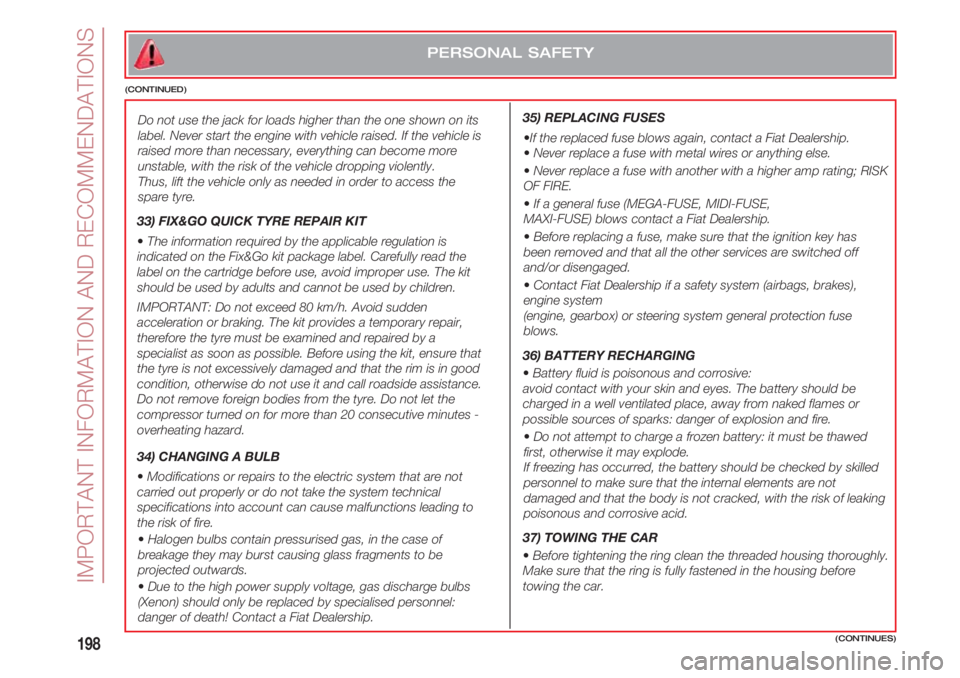
IMPORTANT INFORMATION AND RECOMMENDATIONS
198
PERSONAL SAFETY
(CONTINUED)
Do not use the jack for loads higher than the one shown on its
label. Never start the engine with vehicle raised. If the vehicle is
raised more than necessary, everything can become more
unstable, with the risk of the vehicle dropping violently.
Thus, lift the vehicle only as needed in order to access the
spare tyre.
33) FIX&GO QUICK TYRE REPAIR KIT
•The information required by the applicable regulation is
indicated on the Fix&Go kit package label. Carefully read the
label on the cartridge before use, avoid improper use. The kit
should be used by adults and cannot be used by children.
IMPORTANT: Do not exceed 80 km/h. Avoid sudden
acceleration or braking. The kit provides a temporary repair,
therefore the tyre must be examined and repaired by a
specialist as soon as possible. Before using the kit, ensure that
the tyre is not excessively damaged and that the rim is in good
condition, otherwise do not use it and call roadside assistance.
Do not remove foreign bodies from the tyre. Do not let the
compressor turned on for more than 20 consecutive minutes -
overheating hazard.
34) CHANGING A BULB
•Modifications or repairs to the electric system that are not
carried out properly or do not take the system technical
specifications into account can cause malfunctions leading to
the risk of fire.
•Halogen bulbs contain pressurised gas, in the case of
breakage they may burst causing glass fragments to be
projected outwards.
•Due to the high power supply voltage, gas discharge bulbs
(Xenon) should only be replaced by specialised personnel:
danger of death! Contact a Fiat Dealership.35) REPLACING FUSES
•If the replaced fuse blows again, contact a Fiat Dealership.
•Never replace a fuse with metal wires or anything else.
•Never replace a fuse with another with a higher amp rating; RISK
OF FIRE.
•If a general fuse (MEGA-FUSE, MIDI-FUSE,
MAXI-FUSE) blows contact a Fiat Dealership.
•Before replacing a fuse, make sure that the ignition key has
been removed and that all the other services are switched off
and/or disengaged.
•Contact Fiat Dealership if a safety system (airbags, brakes),
engine system
(engine, gearbox) or steering system general protection fuse
blows.
36) BATTERY RECHARGING
•Battery fluid is poisonous and corrosive:
avoid contact with your skin and eyes. The battery should be
charged in a well ventilated place, away from naked flames or
possible sources of sparks: danger of explosion and fire.
•Do not attempt to charge a frozen battery: it must be thawed
first, otherwise it may explode.
If freezing has occurred, the battery should be checked by skilled
personnel to make sure that the internal elements are not
damaged and that the body is not cracked, with the risk of leaking
poisonous and corrosive acid.
37) TOWING THE CAR
•Before tightening the ring clean the threaded housing thoroughly.
Make sure that the ring is fully fastened in the housing before
towing the car.
(CONTINUES)
Page 202 of 224
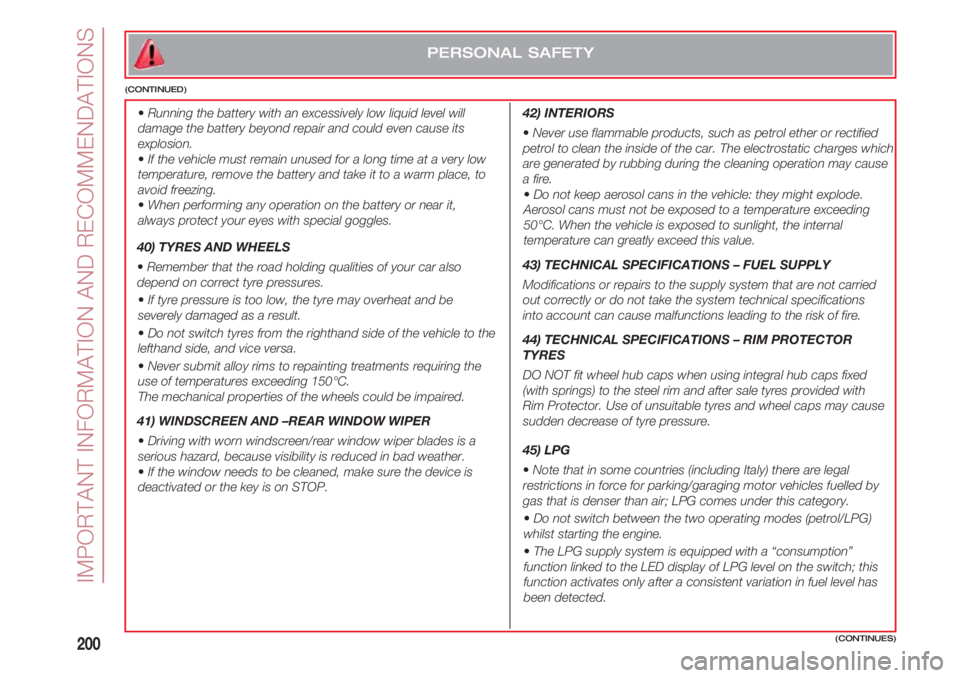
200
PERSONAL SAFETY
(CONTINUED)
42) INTERIORS
•Never use flammable products, such as petrol ether or rectified
petrol to clean the inside of the car. The electrostatic charges which
are generated by rubbing during the cleaning operation may cause
a fire.
•Do not keep aerosol cans in the vehicle: they might explode.
Aerosol cans must not be exposed to a temperature exceeding
50°C. When the vehicle is exposed to sunlight, the internal
temperature can greatly exceed this value.
43) TECHNICAL SPECIFICATIONS – FUEL SUPPLY
Modifications or repairs to the supply system that are not carried
out correctly or do not take the system technical specifications
into account can cause malfunctions leading to the risk of fire.
44) TECHNICAL SPECIFICATIONS – RIM PROTECTOR
TYRES
DO NOT fit wheel hub caps when using integral hub caps fixed
(with springs) to the steel rim and after sale tyres provided with
Rim Protector. Use of unsuitable tyres and wheel caps may cause
sudden decrease of tyre pressure.
45) LPG
•Note that in some countries (including Italy) there are legal
restrictions in force for parking/garaging motor vehicles fuelled by
gas that is denser than air; LPG comes under this category.
•Do not switch between the two operating modes (petrol/LPG)
whilst starting the engine.
•The LPG supply system is equipped with a “consumption”
function linked to the LED display of LPG level on the switch; this
function activates only after a consistent variation in fuel level has
been detected. •Running the battery with an excessively low liquid level will
damage the battery beyond repair and could even cause its
explosion.
•If the vehicle must remain unused for a long time at a very low
temperature, remove the battery and take it to a warm place, to
avoid freezing.
•When performing any operation on the battery or near it,
always protect your eyes with special goggles.
40) TYRES AND WHEELS
•Remember that the road holding qualities of your car also
depend on correct tyre pressures.
•If tyre pressure is too low, the tyre may overheat and be
severely damaged as a result.
•Do not switch tyres from the right hand side of the vehicle to the
left hand side, and vice versa.
•Never submit alloy rims to repainting treatments requiring the
use of temperatures exceeding 150°C.
The mechanical properties of the wheels could be impaired.
41) WINDSCREEN AND –REAR WINDOW WIPER
•Driving with worn windscreen/rear window wiper blades is a
serious hazard, because visibility is reduced in bad weather.
•If the window needs to be cleaned, make sure the device is
deactivated or the key is on STOP.
IMPORTANT INFORMATION AND RECOMMENDATIONS
(CONTINUES)
Page 220 of 224
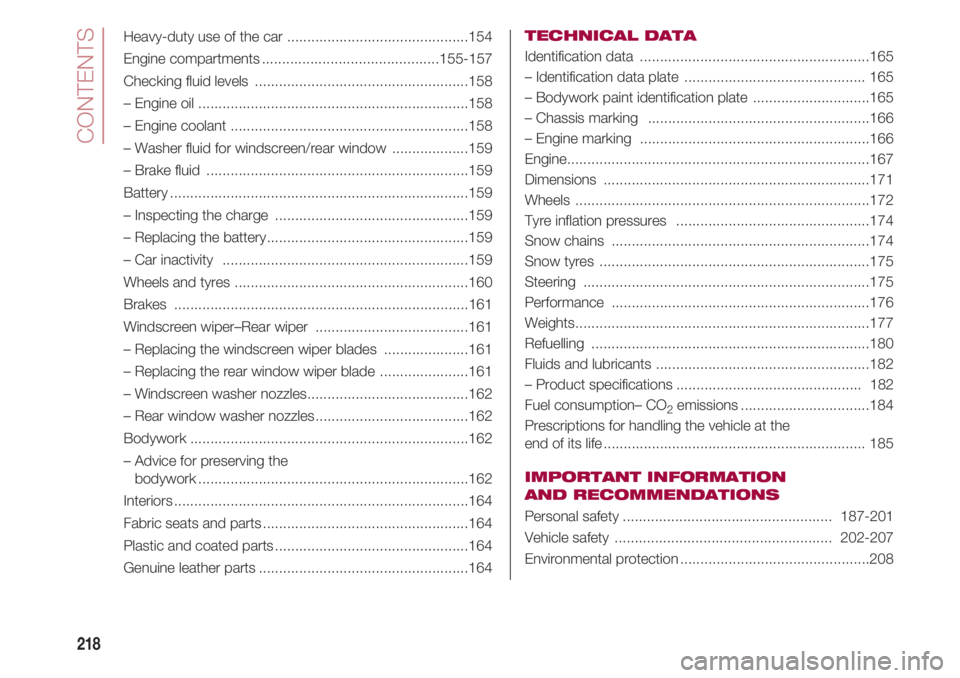
CONTENTS
218
Heavy-duty use of the car .............................................154
Engine compartments............................................155-157
Checking fluid levels .....................................................158
– Engine oil ...................................................................158
– Engine coolant ...........................................................158
– Washer fluid for windscreen/rear window ...................159
– Brake fluid .................................................................159
Battery..........................................................................159
– Inspecting the charge ................................................159
– Replacing the battery..................................................159
– Car inactivity .............................................................159
Wheels and tyres ..........................................................160
Brakes .........................................................................161
Windscreen wiper–Rear wiper ......................................161
– Replacing the windscreen wiper blades .....................161
– Replacing the rear window wiper blade ......................161
– Windscreen washer nozzles........................................162
– Rear window washer nozzles......................................162
Bodywork.....................................................................162
– Advice for preserving the
bodywork...................................................................162
Interiors.........................................................................164
Fabric seats and parts...................................................164
Plastic and coated parts................................................164
Genuine leather parts....................................................164TECHNICAL DATA
Identification data .........................................................165
– Identification data plate ............................................. 165
– Bodywork paint identification plate .............................165
– Chassis marking .......................................................166
– Engine marking .........................................................166
Engine...........................................................................167
Dimensions ..................................................................171
Wheels .........................................................................172
Tyre inflation pressures ................................................174
Snow chains ................................................................174
Snow tyres ...................................................................175
Steering .......................................................................175
Performance ................................................................176
Weights.........................................................................177
Refuelling .....................................................................180
Fluids and lubricants .....................................................182
– Product specifications.............................................. 182
Fuel consumption– CO
2emissions................................184
Prescriptions for handling the vehicle at the
end of its life................................................................. 185
IMPORTANT INFORMATION
AND RECOMMENDATIONS
Personal safety....................................................187-201
Vehicle safety ......................................................202-207
Environmental protection...............................................208